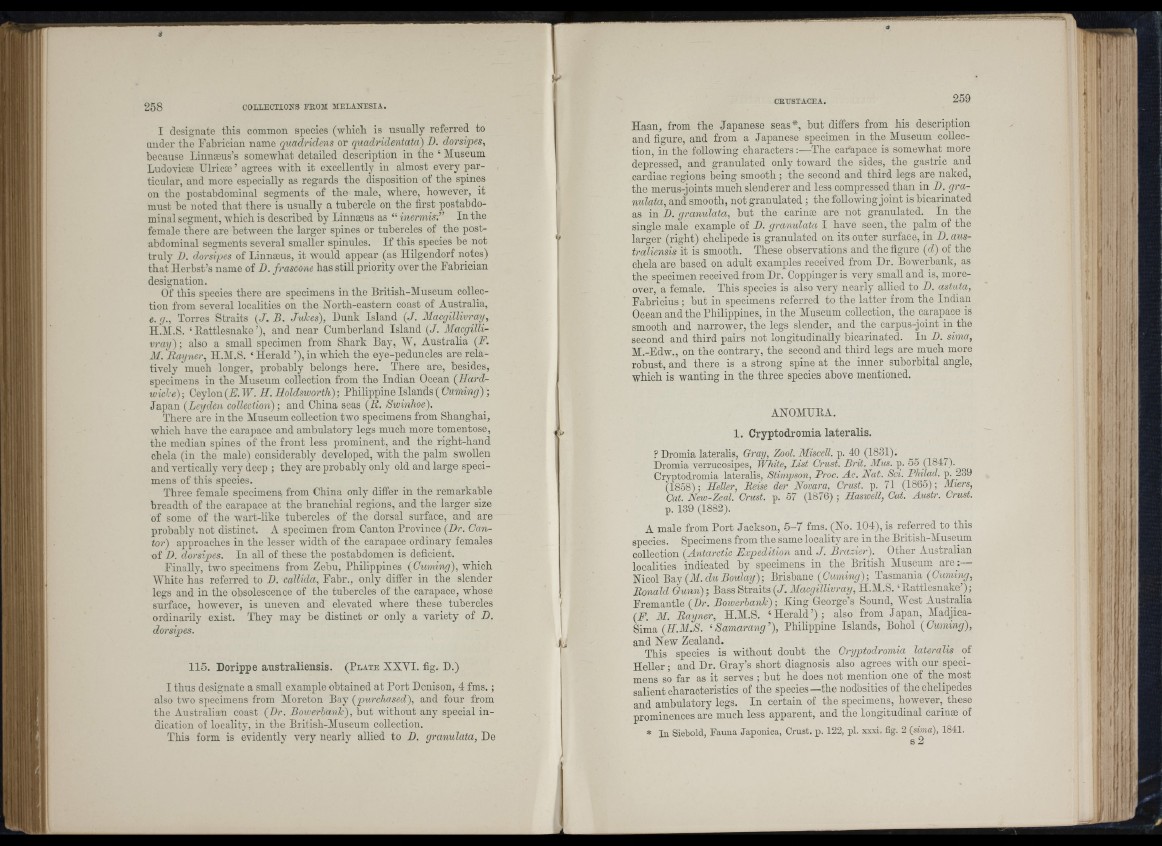
I designate this common species (which is usually referred to
under the Fahrician name quadridens or quadridentata) D. dorsipes,
because Linuæus’s somewhat detailed description in the ‘ Museum
Ludovicæ Ulricæ ’ agrees with it excellently in almost every particular,
and more especially as regards the disposition ot the spines
on the postahdominal segments of the male, where, however, it
must he noted th at there is usually a tubercle on the first postabdominal
segment, which is described by Linnæus as “ inermis.” In the
female there aro between the larger spines or tubercles of the postabdominal
segments several smaller spinules. I f this species be not
truly D. dorsipes of Linnæus, it would appear (as Hilgendorf notes)
th at Herbst’s name of D. f rascone has still priority over the Fahrician
designation.
Of this species there are specimens in the British-Museum collection
from several localities on the North-eastern coast of Australia,
e. (J., Torres Straits (J. B. Jukes), Hunk Island (J. Alacgillivray,
H.Al.S. ‘Battlesnake’), and near Cumberland Island (J. Alacgillivray)
; also a small specimen from Shark Bay, AAh Australia {F.
AI. “Rayner, H.M.S. ‘ Herald ’), in whieh the eye-peduncles are relatively
much longer, probably belongs here. There are, besides,
specimens in the Aluseum collection from the Indian Ocean (Hardwicke),
Ceylon (A. IF. E . Holdsworth) ; Philippine Islands ( C+mMi^r) ;
Japan (Leyden collection) ; and China seas (li. Swinhoe).
There are in the Museum collection two specimens from Shanghai,
which have the carapace and ambulatory legs much more tomentose,
the median spines of the front less prominent, and the right-hand
chela (iu the male) considerably developed, with the palm swoUeu
and verticaUy very deep ; they are probably only old and large specimens
of this species.
Three female specimens from China only differ in the remarkable
breadth of the carapace at the branchial regions, and the larger size
of some of the wart-like tubercles of the dorsal surface, and are
probably not distinct. A specimen from Canton Province (Dr. Cantor)
approaches in the lesser width of the carapace ordinary females
of D. dorsipes. In all of these the postahdomen is deficient.
FinaUy, two specimens from Zebu, Philippines (Cuming), which
AYhite has referred to D. callida, Fahr., only differ in the slender
legs and in the obsolescence of tho tubercles of the carapace, whose
surface, however, is uneven and elevated where these tubercles
ordinarUy exist. They may he distinct or ouly a variety of D.
dorsipes.
115. Dorippe australiensis. ( P l a t e XXVI. fig. D.)
I thus designate a small example ohtained at Port Denison, 4 fm s.;
also two specimens from Aloreton Bay (purchased), and four from
the Australian coast (Dr. Boiverhank), bnt without any special in dication
of locality, in the British-Aluseum collection.
This form is evidently very nearly allied to D. granulata, De
CStrSTACEA. 259
Haan, from the Japanese seas*, but differs from his description
and figure, and from a Japanese specimen in the Aluseum coUection,
in the foUowing characters :—The carapace is somewhat more
depressed, and granulated only toward the sides, the gastric and
cardiac regions being smooth ; the second and third legs are naked,
the merus-joints much slenderer and less compressed than in D. gra-
nulata, and smooth, not granulated ; the foUowing joint is hicarinated
as in D. granulata, hut tho carinæ are not granulated. In the
single male example of D. granulata I have seen, the palm of the
larger (right) chelipede is granulated on its outer surface, iu D. australiensis
it is smooth. These observations and the figure (d) of the
chela are based on adult examples received from Dr. Bowerhank, as
the specimen received from Dr. Coppinger is very small and is, moreover,
a female. This species is also very nearly allied to D. astuta,
Fabricius ; but in specimens referred to the latter from the Indian
Ocean and the PhUippines, in the Aluseum coUection, the carapace is
smooth and narrower, the legs slender, and the carpus-joint in the
second and third pairs not longitudinally hicarinated. In D. sima,
M.-Edw., on the contrary, the second and third legs are much more
robust, and there is a strong spine at the inner suborbital angle,
which is wanting in the three species above mentioned.
ANOMUBA.
1. Cryptodromia lateralis.
? Dromia lateralis, Gray, Zool. Miscell. p. 40^ (1831).
Dromia verrucosipes, JVIiite, List Crust. Brit. AIus. p. 55 (1847).
Crjmtodromia lateralis, Stimpson, Proc. Ac. Nat. Sci. Philad. p. 239
(1858) ; Heller, Reise der Novara, Crust, p. 71 (1865) ; Miers,
Cat. New-Zeal. Crust, p. 57 (1876) ; Haswell, Cat. Austr. Crust.
p. 139 (1882).
A male from Port Jackson, 5 -7 fms. (No. 104), is referred to this
species. Specimens from the same locality are in the British-Museum
coUection (Antarctic Expedition and J. Brazier). Other Australian
localities indicated by specimens in the British Museum a re :—
Nicol Fay (A l.d u Boulay); Brisbane (Cuming); Tasmania (Owning,
Ronald Gunn) ; Bass Straits (J. Alacgillivray, H.M.S. ‘ Battlesnake’) ;
Eremantle (Dr. Bowerhank); King George’s Sound, AA*est Australia
(F. AI. Bayner, H.Al.S. ‘H e ra ld ’) ; also from Japan, Aladjica-
Sima (ff.ili.N. ‘ Samarang’), Philippine Islands, Bohol (Cuming),
and New Zealand. . t n
This species is without doubt the Cryptodromia^ latercdis of
Heller ; and Dr. Gray’s short diagnosis also agrees with our specimens
so far as it serves ; but he does not mention one of the most
salient characteristics of the species—the nodosities of the chelipedes
and ambulatory legs. In certain of the specimens, however, these
prominences are much less apparent, and the longitudinal carinæ of
* In Siebold, Fauna Japónica, Crust, p. 122, pi. xxxi, fig. 2 (sima), 1841.
a 5
■( (
J
I :
/
il -
r
li!